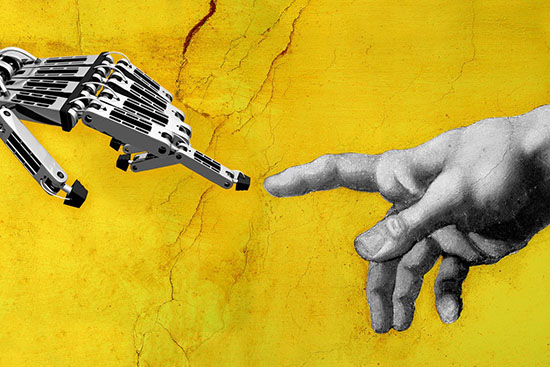人工智能:幾分炒作幾分現實?
|
就像蜂蜜會引來蜜蜂一樣,技術趨勢也會引來炒作。在互聯網的黃金時期,單純把“dotcom”一詞與某家公司的名字掛鉤就能帶來股價的上漲。云計算、大數據、加密貨幣,這些詞近年來輪番成為炒作圈的熱點。每一股潮流都帶來了真正前景廣闊的技術發展、令人頭暈腦脹的流行詞、狂熱的投資者以及提供啟示的可靠顧問——當然,這是收費的。
作為當下最具典型性的技術潮流,人工智能領域已經涌現出了包羅萬象的短語。然而,它被吹捧得過于無所不能,乃至于各企業都在冒險拔高對它的期望——也浪費了不少資金來嘗試將這項技術用于它無法解決的問題。
想想泡沫出現的預警信號。風險投資家在贊助人工智能上已經超越了熱心的范疇。研究公司PitchBook表示,這些人去年給1,028家人工智能相關的初創公司提供了資金,比起2013年的291家大幅提升。其中有26家公司的名字中包含“人工智能”,而五年前僅有一家。此外,還有大量會議打算向愚昧的管理者解釋人工智能。在今年的瑞士達沃斯世界經濟論壇(World Economic Forum)年度會議的議程中,有不少于11場涉及人工智能的專題討論,題目都類似于“設計你的人工智能戰略”、“為人工智能競賽設立規則”。(《財富》雜志也趕了一次時髦,2018年在中國廣州舉辦的《財富》全球科技論壇中也滿是關于人工智能的討論。)
結果就是,這個嚴肅的問題有了嘩眾取寵的風險。麻省理工學院(MIT)數字經濟項目的研究員邁克爾·施拉格表示:“如果擁護者不謹慎一些,就會成功地讓人工智能比特幣化。”
別誤解,人工智能遠不只是一場短暫流行的潮流。它代表了一種全新的經營方式,是對自動化、基于感應器的工業監控和商業過程算法分析的現有趨勢的強化。計算機科學已經幫助機器在完成日常工作上比人類更快。而結合了史上最強計算能力和多年來數字化數據積累的新型人工智能技術,意味著計算機可以第一次學習人類要求它們完成的任務,而不是單純完成人類的指令。 |
Like bees to honey, tech trends generate hype. Merely appending the word “dotcom” to a company’s name drove up stock prices in the Internet’s salad days. Cloud computing, big data, and cryptocurrencies each have taken their turn in the hype cycle in recent years. Every trend brings genuinely promising technological developments, befuddling buzzwords, enthusiastic investors, and reassuring consultants offering enlightenment—for a fee, naturally.
Now the catchall phrase of artificial intelligence is shaping up as the defining technological trend of the moment. And yet, because the claims of what it will achieve are so grand, businesses risk raising their hopes for A.I. too high—and wasting money by trying to apply the technology to problems it can’t solve.
Consider the bubbly warning signs. Venture capitalists are beyond eager to fund A.I. They staked 1,028 A.I.-related startups last year, up from 291 in 2013, says researcher PitchBook. Twenty-six of those companies had “A.I.” in their names, compared with one five years earlier. Then there’s the profusion of conferences promising to explain A.I. to the benighted manager. At the annual meeting of the World Economic Forum in Davos, Switzerland, the agenda this year included no fewer than 11 panels that reference A.I., with names like “Designing Your A.I. Strategy” and “Setting Rules for the A.I. Race.” (Fortune has gotten into this act too: Its 2018 Global Tech Forum in Guangzhou, China, was dominated by A.I. discussions.)
The result is a serious subject running the risk of jumping the shark. “If advocates are not careful, they will have successfully Bitcoinized A.I.,” says Michael Schrage, a researcher at MIT’s Initiative on the Digital Economy.
Make no mistake—artificial intelligence is more than a fad. It represents a whole new way of doing business by turbocharging the existing trends of automation, sensor-based industrial monitoring, and algorithmic analysis of business processes. Computer science was already helping machines perform routine tasks more quickly than humans. The new techniques of A.I.—combined with ever faster computing power and the accumulation of years of digitized data—mean that for the first time computers learn the tasks humans require of them rather than merely doing as they’re told. |

|
卡耐基梅隆大學(Carnegie Mellon University)的機器學習教授湯姆·米切爾表示,它引發的結果不亞于“影響未來十年社會和生活方式的主要推動力量之一”。對商業而言也是如此:研究公司IDC預測,未來三年內在人工智能上的投入將接近800億美元。咨詢公司埃森哲(Accenture)的首席技術和創新官保羅·多爾蒂推測這個數字還可能偏低,因為“它沒有計算各公司圍繞人工智能進行轉型的投資”。
但是,就像其他任何激動人心的技術一樣,人工智能可以實現的事情也是有限的。無人駕駛汽車就是完美的例子。我們已經有了在理想情況下讓這些汽車行駛的技術,但即使是Alphabet無人駕駛汽車子公司Waymo的首席執行官約翰·克拉福西克也承認如果沒有人類的操控,它們永遠也不可能在所有的天氣條件下工作。此外,計算機很擅長學習定義明確的任務,例如識別照片中的人物,或是準確將演講轉成文字。但理解人類動機或根據文字得出微妙的結論(通過人類所擅長的洞察力)仍然超出了機器的能力范圍。卡耐基梅隆大學的米切爾表示:“我們在讓這類功能產品化方面仍然處于相當早期的階段。”
還有很多事無法通過人工智能實現,這應該會讓很多首席執行官放下心來。斯坦福大學(Stanford University)的技術經濟學教授蘇珊·埃塞在她的高管教育課程上打消了經理們對于自身價值的疑慮,認清了他們招聘的人工智能科學家的局限性。埃塞表示:“他們新招入的博士,卻在回答為什么起不到效果的方面沒有經驗,也不知道哪些項目不能做。”她說,人工智能無可非議地“帶來了魔幻般的感覺”。但它最擅長在設計者準備好的情境里進行分析,而不是對從未見過的問題做出決定。埃塞表示:“讓人工智能幫你管理一切,這是錯誤的認知。”
換句話說,人工智能不是解決所有問題的殺手锏。蒙特利爾的軟件初創公司Element AI的首席執行官讓-弗朗索瓦·加涅提醒客戶稱,只有當人工智能獲取足夠量的數據之后,解決方案才會變得出色。他表示:“讓各個機構矚目的機遇,其實是獲取自適應系統的能力。這是一場旅程。那不是你可以花錢購買,然后啟動開關就能使用的技術。按照人工智能的定義,它需要時間學習。”
加涅認為,建立一個有效人工智能的過程,好比“教導孩子做正確的事情,與他成年后擁有正確的行為”的差異。我們恐怕還需要同樣長的時間,才能弄清企業是否準確把握了如今這個人工智能的契機。而還有另一種可能:人工智能只是又一個極度昂貴而又難以捉摸的金錢陷阱。(財富中文網)
本文的另一個版本登載于《財富》雜志2019年2月刊,標題為《請以批判的目光看待炒作人工智能的商人》。 譯者:嚴匡正 |
The result, says Tom Mitchell, a machine-learning professor at Carnegie Mellon University, is nothing less than “one of the major forces for society and lifestyle of the next decade.” And commerce too: Researcher IDC predicts spending on A.I. will near $80 billion in three years. Paul Daugherty, chief technology and innovation officer of consultant Accenture, reckons that figure will prove low because “it doesn’t account for the investment companies are making in transformation around A.I.”
Yet, as is the case with any exciting technology, there are limits to what A.I. can accomplish. Self-driving cars are the perfect example. We already have the technology for them to operate under ideal circumstances, but even John Krafcik—CEO of Alphabet’s self-driving car subsidiary Waymo—admits they’ll never be able to drive in all weather conditions without some human input. What’s more, computers are very good at learning clearly defined tasks, like identifying people in photographs or accurately transcribing speech. But understanding human motivations or drawing nuanced conclusions from text—insights at which humans excel—remains beyond the machines. Says CMU’s Mitchell, “We’re still in the very early stages of trying to productize this.”
What A.I. can’t yet do ought to be of some comfort to CEOs. Susan Athey, a professor of the economics of technology at Stanford University, reassures managers in her executive education courses of their worth—and also the limitations of the A.I. scientists they hire. “New Ph.D.s are all bought in, but they don’t have the experience of what doesn’t work, which projects not to do,” she says. A.I., says Athey, justifiably “feels magical.” But it is best at analyzing situations its designers have prepared it to interpret, as opposed to making decisions on subjects it hasn’t seen before. “It’s just not right that your A.I. will manage for you,” says Athey.
A.I., in other words, is no silver bullet. Jean-Fran?ois Gagné, CEO of the Montreal software startup Element AI, reminds clients that A.I. solutions are only as good as the accumulated data being fed into them. “The opportunity every organization is looking at is the ability to have adaptive systems,” he says. “It is a journey. It is not something you can buy and suddenly flip a switch. By the very definition of A.I., it takes time to learn.”
Gagné analogizes the process of building a useful A.I. to the difference between “teaching your children the right thing versus getting the right behavior in adulthood.” It will take at least as long to know if businesses were able to properly grasp this A.I. moment—or if it was another extremely expensive and elusive money pit.
A version of this article appears in the February 2019 issue of Fortune with the headline “Cast a Critical Eye Over the A.I. Hype Merchants.” |











